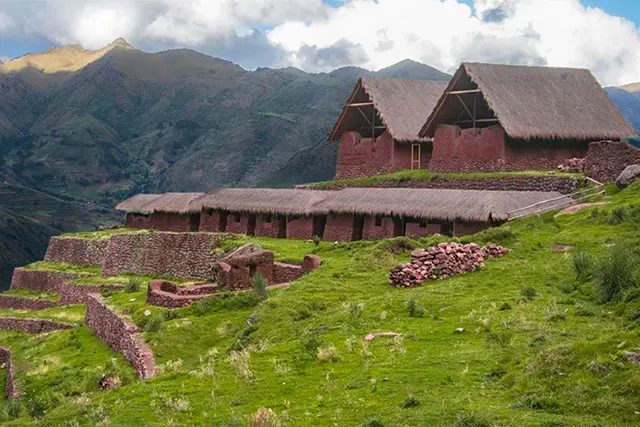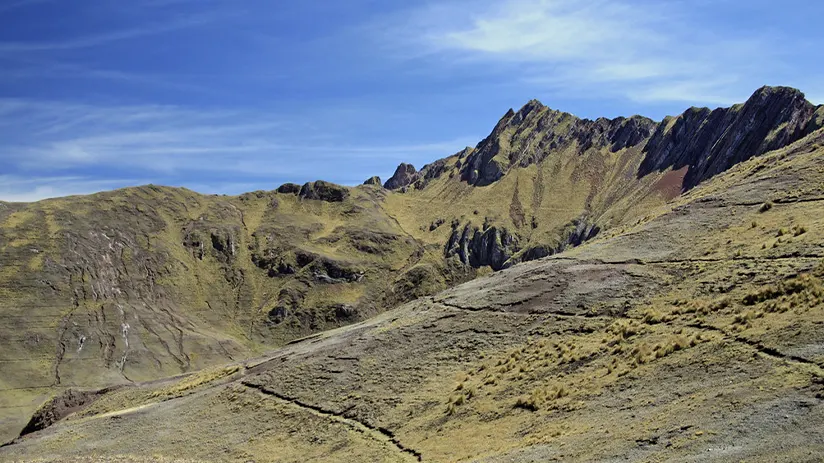If you are considering traveling to Cusco and want to experience one of the most incredible hikes, Huchuy Qosqo is definitely on our list of things to do in Sacred Valley. This place is located north of the Cusco region and means “Little Cusco”. According to historians and scholars, it was an administrative and military center during the Inca civilization. Join us with Machu Travel Peru to explore this fascinating place in South America:
Huchuy Qosqo is a hidden gem that allows you to experience the grandeur
- Location
- History of Huchuy Qosqo
- What to see
- How to get to Huchuy Qosqo
- Best time to visit
- Huchuy Qosqo Trek
- What to Bring
- Frequently questions
Location

Huchuy Qosqo is situated above the town of Lamay in the Peruvian Andes, in the Sacred Valley of the Incas. Huchuy Qosqo or little Cusco, is an amazing Inca Archaeological site located north of Cusco at 3,650 m/ 11,975 ft. The name comes from the Quechua language that means “Little Cusco”.
It was crucial for managing the valley and enabling communication between various Inca villages because of its advantageous location, which offers both natural defense and a commanding view of the surroundings. Due to its ridgetop location, the site is easily reachable by foot from Lamay or via the well-known Huchuy Qosqo Trek.
Huchuy Qosqo or little Cusco, is an amazing Inca Archaeological site located north of Cusco at 3,650 m/ 11,975 ft. The name comes from the Quechua language that means “Little Cusco”.
History of Huchuy Qosqo

| Period | Event |
| Pre-Inca Era | The region was likely inhabited by pre-Inca cultures, such as the Killke, before the rise of the Incas. Evidence of earlier settlements can be seen in the site’s architecture and layout. |
| Inca Empire (15th Century) | Huchuy Qosqo became an important royal estate, likely during the reign of Inca ruler Pachacuti. It served as a retreat, administrative center, and agricultural hub, featuring large terraces and advanced water systems. |
| Post-Inca Era (16th Century) | Following the Spanish conquest, the site was abandoned, and much of its significance diminished under colonial rule. The area remained largely forgotten for centuries. |
| Rediscovery (20th Century) | In the early 20th century, Huchuy Qosqo was rediscovered by explorers and archaeologists, sparking interest in its Inca heritage. Efforts to study and preserve the site began. |
| Today | Huchuy Qosqo is a popular destination for trekkers and archaeologists, offering a glimpse into Inca civilization. It remains a key site for understanding Inca imperial expansion and engineering. |
What to see

At Huchuy Qosqo, visitors can explore a variety of fascinating features that highlight Inca engineering, architecture, and agricultural practices. Here’s what to see:
- Main Complex and Buildings: The site includes well-preserved structures made with finely cut stonework, characteristic of Inca architecture. Notable buildings include large rectangular rooms that were likely used for ceremonial or residential purposes, offering a glimpse into Inca royal life.
- Agricultural Terraces: Huchuy Qosqo is famous for its extensive agricultural terraces, which were used for farming and show the Incas’ advanced techniques in managing agricultural production. These terraces are impressive for both their scale and the sophisticated irrigation systems that supported them.
- Water Channels: Ingenious water management systems, including channels that divert water for irrigation, are found throughout the site. These systems reflect the Incas’ expertise in hydraulics, which was essential for sustaining agriculture in such a rugged landscape.
- Panoramic Views: The site is located on a ridge that offers stunning panoramic views of the Sacred Valley, with sweeping vistas of the surrounding mountains and the Lamay Valley below. This location was likely chosen for its strategic and symbolic significance.
- Inca Roads: The Inca road system, which connected important sites throughout the empire, runs near Huchuy Qosqo. Visitors can walk along sections of these ancient pathways, which once served as vital routes for trade and communication.
These features, combined with the scenic hiking route that leads to Huchuy Qosqo, make it a captivating site for those interested in Inca history, archaeology, and the natural beauty of the Andes.
How to get to Huchuy Qosqo

Depending on whether you choose to hike or take a more direct path, there are two main ways to get to Huchuy Qosqo. To go there, follow these steps:
1. Hiking from Lamay
Trekking from the Sacred Valley hamlet of Lamay is the most common route to Huchuy Qosqo. A beautiful, less demanding option to the Inca Trail, the Huchuy Qosqo Trek includes the hike, which usually lasts two to three days.
2. Take a car from Cusco
You may drive to Huchuy Qosqo via Tambomachay, an Inca archaeological site close to Cusco if you’d rather take a shorter route. A dirt road will take you to the archaeological site from here. Depending on the state of the roads, the drive from Cusco usually takes two hours.
Route: Travel to Tambomachay from Cusco, then continue on the gravel road to Huchuy Qosqo. A 4×4 car can handle the trip even though the route may be uneven.
Alternative: To arrange transportation and get you to the location, you might work with a local guide or travel agency.
3. Tours with a guide
You can also reserve a guided excursion that covers transportation and a guided hike to Huchuy Qosqo for convenience. Numerous tour companies in Cusco provide packages that include the walk plus a stop at other neighboring locations, such as Ollantaytambo and the Sacred Valley. These tours usually include a guided tour of the ancient site after transportation to the hike’s starting point.
Best time to visit

The best time to visit Huchuy Qosqo is during the dry season, which runs from May to September. This period offers the most favorable weather conditions for trekking and exploring the site. During these months, the weather is typically sunny and clear, with less rainfall, making the hiking trails more accessible and enjoyable.
The dry season also brings cooler temperatures in the mornings and evenings, which is ideal for high-altitude trekking experiences. The views of Sacred Valley and surrounding mountains are at their most breathtaking, with clear skies offering perfect photo opportunities.
In contrast, the rainy season, from November to March, can make the trails slippery and more challenging to navigate due to heavy rains. The lush greenery during this time can be beautiful, but the constant rain may hinder your experience of the archaeological site.
The weather can also be unpredictable, with occasional downpours that might disrupt outdoor activities. However, if you don’t mind the rain and prefer fewer crowds, the rainy season could still be an option. Overall, for optimal conditions, the dry season remains the best time to visit Huchuy Qosqo, ensuring a safe and scenic adventure.
Tips and recommendations
- Climate: The climate in Huchuy Qosqo varies according to the time of year. During the dry season (May to September), conditions are more favorable for trekking, with sunny days and cool nights. During the rainy season (November to March), trails can become slippery, so caution is advised and be prepared for rain.
- Altitude: Since Huchuy Qosqo is located at a high altitude (3,600 meters), it is important to acclimatize before trekking. It is advisable to spend a few days in Cusco or the Sacred Valley to adapt to the altitude and avoid altitude sickness.
- Guides and Tours: Although the trekking is accessible, it is recommended to hire a local guide, as they will not only know the best trails but will also be able to share interesting information about the history, geography, and culture of the region.
Huchuy Qosqo Trek

The trek to Huchuy Qosqo is a popular activity for travelers seeking a more off-the-beaten-path experience. The trail can be completed in one day and varies in difficulty depending on the route chosen. Hikers typically start in Chinchero or Tambomachay and make their way through rugged terrain, ascending into the mountains before descending to the site itself and starting point.
- Duration: 6-7 hours of hiking, depending on the route and pace.
- Difficulty: Moderate. The trek includes steep ascents and descents at high altitude, so proper acclimatization is recommended.
- Scenery: The hike offers panoramic views of the Sacred Valley, with its stunning landscapes, mountains, rivers, and valleys that you can explore in 45 minutes.
Know as “Litle Cusco”, Huchuy Qosqo is a prominent trekking and adventure destination in the Cusco Region.
What to Bring

Wear appropriate clothing
- Hiking boots
- breathable, moisture-wicking clothing (eg. quick – dry shirts and pants)
- Thermal or wool base layers for colder temperatures
Essential
- Valid passport
- Extra money
- Personal medication
- Water bottle or Camelbag
- Huchuy Qosqo
Frequently questions

1. What is Huchuy Qosqo?
Huchuy Qosqo, which means “Little Cusco” in Quechua, is an ancient Inca archaeological site located in the Sacred Valley of the Incas, near the town of Lamay, in the Cusco region of Peru. Pedro Cieza de León believes that it served as an administrative center and a high-ranking royal residence during the Inca Empire, featuring impressive agricultural terraces, stone buildings, and advanced hydraulic systems.
2. How can I get to Huchuy Qosqo?
The most common way to get to Huchuy Qosqo is by trekking, starting in the village of Lamay or from the archaeological site of Tambomachay. The trekking usually lasts between 1, 2, and 3 days, depending on the chosen route. It is also possible to take a vehicle to the site, but the experience of walking through the Andean landscapes is very popular among tourists.
3. What is the best time to visit Huchuy Qosqo?
The best time to visit Huchuy Qosqo is during the dry season, which runs from May to September, when the weather is more favorable for trekking, with clear skies and more pleasant temperatures. During the rainy season, from November to March, conditions can be slippery and wet, making trekking difficult.
4. Do I need a guide to complete the trek?
Trekking without a guide is feasible, but for a more secure and enjoyable trip, it is advised to hire one. Local guides can assist you in navigating the area because they are well-versed in its history, culture, and geography.
5. What is the travel time to Huchuy Qosqo?
Depending on the pace and stops made along the way, the hike from the settlement of Lamay to Huchuy Qosqo usually takes two to three days. The trip is quicker if you drive to the location; it takes roughly two hours from Cusco or one hour from Ollantaytambo.
6. What things to do in Cusco?
The best things to do in the Cusco are the following:
- Visit the inca citadel of Machu Picchu
- Explore Moray archeological site
- Walk through the Maras Salt mines
“LIVE WITH NO EXCUSES AND TRAVEL NO REGRETS”
We’re happy to have you join us at Machu Travel Peru. We hope you enjoy your experience and continue discovering the magic of our ancient treasures!
Peru has so much to offer, it can be hard to know where to start. With many years of experience in the tourism sector, Machu Travel Peru is happy to help with anything regarding your trip to Machu Picchu and any tours around it. Make your Machu Picchu experience an unforgettable one!
